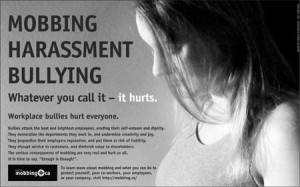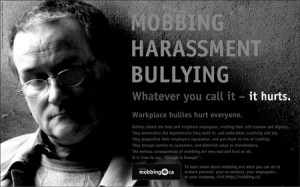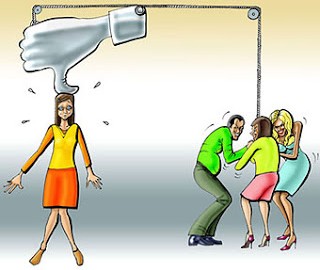Workplace mobbing: causes and preventions
- 75% of the employees have stolen from their enterprise (McGurn, 1998);
- Behaviors such as theft, fraud, vandalism, sabotage, absenteeism affect 35-75% of employees (Harper, 1990);
- 42% of the French said they had been sexually harassed in the workplace (Webb, 1991).
…

source: members.shaw.ca
All these figures tell us that almost everyone is involved in the workplace deviance, either being a « performer », or being a victime.
Definitions
A deviant person is the one whose behavior deviates from the accepted social norm. The workplace deviance so depends on how the organization defines their workplace norms. Among all the workplace deviance behaviors, the workplace mobbing is on the rise.
According to one of the pioneered researchers in this area, a Swedish scientist called Heninz Leymann, workplace mobbing is a type of bullying where more than one person commits egregious acts to control, harm and eliminate a targeted individual in the workplace. Mobbing is not personality conflit; rather, there is a particular vulnerability presented in the targeted individual.
In the book MOBBING: Emotional Abuse in the American Workplace, the authors say that mobbing is typically found in work environments that have poorly organized production and/or working methods and incapable or inattentive management and that mobbing victims are usually《exceptional individuals who demonstrated intelligence, competence, creativity, integrity, accomplishment and dedication.
Causes

source: members.shaw.ca
The causes of the workplace mobbing can be variant. Like what’s been quoted above, due to some poorly organized production and/or working methods; and especially when the management is incapable or inattentive to the actual status of the employees, for instance when a company is facing an economic crisis. At this point of time, if by performing « deviantly » upon their own actions towards the company (i.e., theft, fraud, vandalism, sabotage, absenteeism), they can’t obtain a certain kind of satisfaction in terms of company destruction, they may turn over to their colleges. Or, it’s also possible that the targeted individual of the mobbing is seen as a threat to be removed.
Interventions and preventions
What’s important in reducing the workplace mobbing, and all kinds of workplace deviance behaviors, is to first of all establish an organizational justice system.
That is to say, procedural justice, distributive justice, and interactional justice.
- Procedural justice is the way that a decision is made. Despite the sensibility to the ways that a decision is made, it is sensible to the justice characteristics.
- Distributive justice is the employees’ evaluation about the distributed ressources; like « Is all what we encountered fair? ».
- Interactional justice concerns about how one decision is made and announced.
More specifically, when it comes to mobbing, there are some tips that a manager can follow:
- Make sure that the right person is in the right position and guarantee the productivity of the group works.
- Establish a justice system so that no one can question the organizational justice.
- Execute a code of conduct in order to protect the employees from psychological harm. And make this code part of the daily practice.
- And if possible, include an employee assistance program with company benifits that includes psychological counseling for targets, like a social psychologist specialized in the prevention of socio-psychological risks once a problem occurred.
Source:
- « http://psychcentral.com/blog/archives/2013/12/28/bullying-at-work-workplace-mobbing-is-on-the-rise/ » Bullying at work: Workplace mobbing is on the rise
- « http://www.examiner.com/article/an-overview-of-mobbing-the-workplace » An overview of mobbing in the workplace
- « http://englishhungry.blogspot.fr/2010/10/reading-comprehension-workplace-mobbing.html » Reading comprehension: Workplace mobbing
For further:
- Duffy, M. & Sperry, L. (2013). Overcoming Mobbing: A Recovery Guide for Workplace Aggression and Bullying. USA: Oxford University Press.
- Faure-Brac, J. (2012). « http://www.aph.gov.au/~/media/05%20About%20Parliament/53%20HoR/537%20About%20the%20House%20magazine/46/PDF/Poison1.ashx » A slow Poison: Behind The Alarming Statistics On Workplace Bullying Are Personal Stories Of Grief And Hardship, Revealed During A Parliamentary Inquiry.
- Harris, L.C. & Ogbonna, E. (2006). Service sabotage: A study of antecedents and consequences. Academy of Marketing Science Journal, 34(4), 543-599.
—————————–
Authored by :
 Huansha YIN Chargée de communication et de marketing (stagiaire) chez SpotPink. Je suis actuellement en Master 1 de Psychologie, Environnement et Menaces Sociales à l’université Paris Descartes. Véritablement intéressée par le domaine de la communication, j’explore ce sur quoi peut intervenir la psychologie dans ce domaine. Passionnée de cinéma et de voyage, j’aime faire la découverte de nouvelles cultures et de nouvelles langues./p>
Huansha YIN Chargée de communication et de marketing (stagiaire) chez SpotPink. Je suis actuellement en Master 1 de Psychologie, Environnement et Menaces Sociales à l’université Paris Descartes. Véritablement intéressée par le domaine de la communication, j’explore ce sur quoi peut intervenir la psychologie dans ce domaine. Passionnée de cinéma et de voyage, j’aime faire la découverte de nouvelles cultures et de nouvelles langues./p>




Les commentaires sont désactivés.